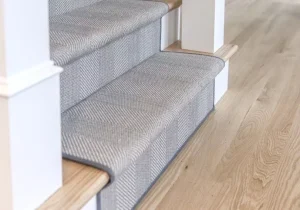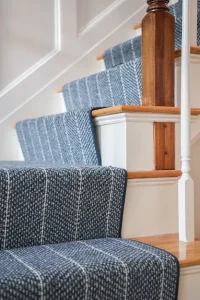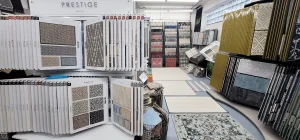At The Carpet Workroom, we are constantly working on various types of carpeting and rug projects. One that we regularly get requests for are stair runners. A stair runner has always been a popular and favorite flooring option to install in homes for both its looks and benefits.
If you’re looking to get a stair runner installed in your space, or perhaps you’re thinking of changing one you already have installed, it’s important that you have a general idea of the stair-runner decision-making process before you dive right in. We’ve put together this guide to highlight the important details you should keep in mind before you start on a stair-runner project.
Put in the simplest terms, a stair runner is a finished carpet broadloom that is shaped out to be placed over a set of stairs. Stair runners are just one way that stairs can be covered. You can also go with a wall-to-wall carpet or stair treads. What makes a stair runner unique is that it’s not intended to cover the entire set of stairs, like wall-to-wall carpet, nor does it have any gaps between each step the way stair treads do. Rather, it only covers a certain width of the stairs while still showing off some of the original stairs. The final result is a staircase with an elegant look!
Installing a stair runner is much more than just a stylish addition to your home. Having one installed also carries benefits that will have you thanking yourself later for the installation.
Protect Hardwood Flooring:
One of the main reasons you might want to get a stair runner installed is because of the added protection it provides to your set of stairs, particularly if you have hardwood floors. A stair runner not only protects that flooring, but it also allows it to last much longer. Also worth noting is that when stair runners are installed, there is a padding placed underneath so your stairs are receiving the ultimate protection they deserve.
Add a Decorative Touch to your Home:
Stair runners are a stylish way to bring some life into your home. They offer the flexibility to design a look that will truly stand out. With so many different colors, patterns, carpet materials, and various small details to choose from, a stair runner can be a great way to make your home unique. You have the opportunity to make a statement and create a look that truly reflects your creativity.
Cover up High-Traffic Areas:
Over time, high foot traffic can leave damage on flooring or cause fading. Instead of having the flooring replaced, you can invest in a stair runner which will help cover up those blemishes. At the end of the day, you’ll be adding an elegant touch to your home and could even be saving yourself some money down the road.
Prevent Slipping:
Many people like to walk around their homes in socks, however this can be a risky situation if you have hardwood flooring on your stairs. Accidents can easily be avoided by installing a rug runner on your stairs! Stair runners easily add a layer of traction so you can travel up and down your stairs without the worry that you’ll slip. These make especially great additions to homes with children or elderly folks.
Absorb Noise:
Whether its kids racing down the stairs or constant foot traffic, stair runners are a great way to cover up noise pollution. The carpet will absorb footfall noise and can instantly quiet down a home. If your objective in installing a stair runner is to cut noise pollution, you would want to choose a thicker carpet material.

The two most common stair runner styles you can go with are called “Hollywood” and “Waterfall.” With the Waterfall style, the carpet material is brought over the edge of the tread and straight down the riser to meet the next tread. The drop over the edge gives your stair runner a waterfall look as it cascades down to the next step.

Contrary to the “Waterfall” look, the Hollywood carpet involves attaching the carpet material directly to the staircase by stapling the runner under the nose of the stair. To learn more about the differences between these styles, refer to the blog post Hollywood vs Waterfall: Which Stair Runner Installation Method Should I Go With?
There are a variety of carpet options to choose for your stair runner. However, when picking out a carpet material, you have to take many things into consideration before making that final decision. Here are a few material options and what you should mull over while considering your final choice.

At The Carpet Workroom we have a vast variety of materials and styles to choose from. If you’re ever in doubt, our project managers will work alongside you to make sure you choose the right carpet material!
When picking out a material you have to take many things into consideration before you make that final decision. The type of material you can choose can impact what you want your stair runner to achieve.
For example, if…
If there is already a carpet runner on your stairs, this will need to be removed before adding a new runner. Next, carpet padding should be installed before the carpet for an extra level of protection. Don’t worry – you don’t need to do any of this yourself. Our professional team of carpet experts can prep your stairs and install the stair runner of your choice.
Stair runners are great investments that make a great addition to any home! If you’re ready to get your stair runner project started, reach out to us at info@carpetworkroom.com with pictures and measurements of your space, and any photos of what you have in mind. Browse our image gallery for design inspiration. We will get back to you with the next steps in the installation process.
Browse carpet options on our online rug shop or make an appointment to visit our physical showrooms in Needham, MA or Stoughton, MA.